Are you interested in the rich and ancient history of Medieval England? This article lays out a roadtrip that takes you straight up the UK using castles built in the 11th Century as your markers. You can practically follow the conquest of the first Norman King, William the Conqueror, and learn the thousand year history behind many of England’s most iconic settlements. The trip also takes you pass popular cities and national parks, as well as other well-known castles, letting you veer off and tailor your trip to your needs.
Arundel Castle
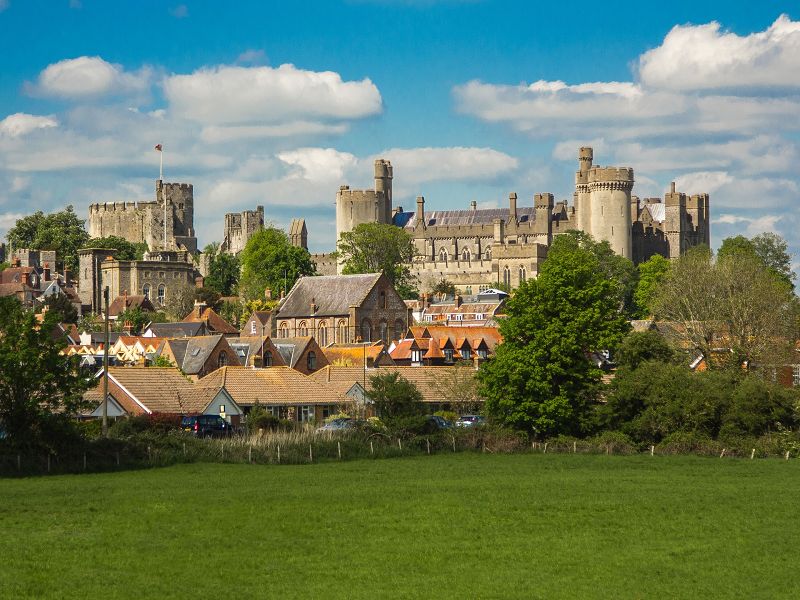
Starting at the bottom of England in West Sussex, it’s recommended visiting Arundel Castle. This places you near the iconic seaside city of Brighton and Hove. Brighton is a great place to spend the weekend as many Londoners and other Southern Englanders do. It’s filled with Victorian architecture, an active fairground pier, some of the UK’s best pubs and a University – making for great nightlife or a fun day out. If you really want to see more of the UK coast, Eastbourne is not far either.
Arundel Castle is from the Medieval era, established by Roger de Montgomery. He lay the work on Christmas day in 1067, and became the first Earl of Arundel as appointed by William the Conqueror – the first Norman King of England. History fanatics will know the story of William the Conqueror as depicted in the Bayeux Tapestry.
He invaded England in 1066 marking one of the most famous Medieval battles in history, the Battle of Hastings, a victory that marked the beginning of Norman rule over England. Roger de Montgomery was William’s cousin and was placed in the region to keep peace after the invasion. After his death the property ownership was reverted to King Henry I, who in turn left it to his second wife, Adeliza of Louvain. In 1138 she married William d’Albini II who built the castle’s motte.
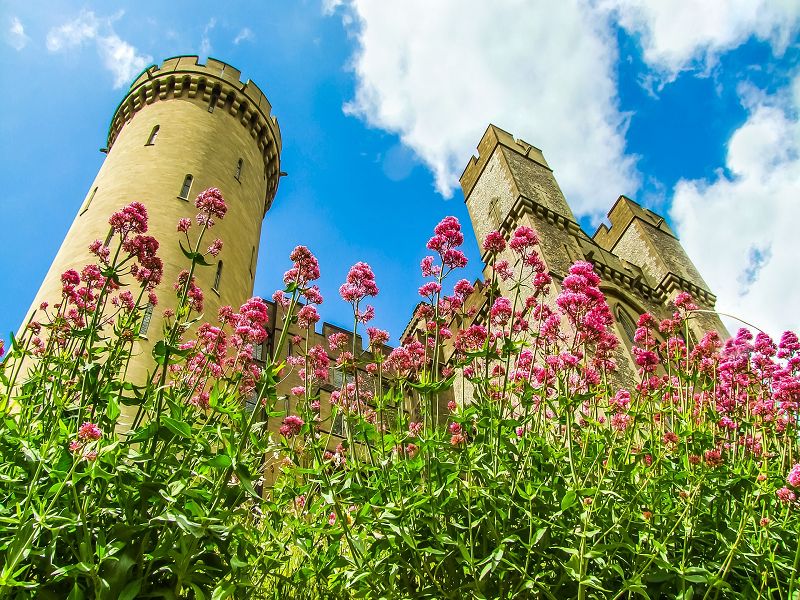
The castle is filled with history and has hosted some of England’s most famous rulers from King Richard I ‘The Lionheart’ to Queen Victoria. Since 1138 to this very day it has passed in ownership almost directly – from the d’Albinis to the Fitzalans in the 13th Century and then from the Fitzalans to the Howards in the 16th Century, it has since been the seat of the Duke of Norfolk and their ancestors for over 850 years and is even still occupied today.
The castle has had many times of restoration and disparagement having survived such events the Wars of the Roses, the Tudor period and the Civil War. In later centuries though it went through vast restoration, with entire apartments built specially for Queen Victoria’s visit in 1846. Visitors today can marvel at the exquisite gardens, antique furniture as well as surviving ancient structures.
The grounds open at 10:00 and closes at 16:30 or 17:00 depending on which rooms. Guided tours are available and there is a restaurant and café. Plan ahead to see if any special events are taking place.
- Distance to Brighton : 22.3 miles, 48 min
- Distance to London: 2 hours (to centre, traffic dependent)
Warwick Castle
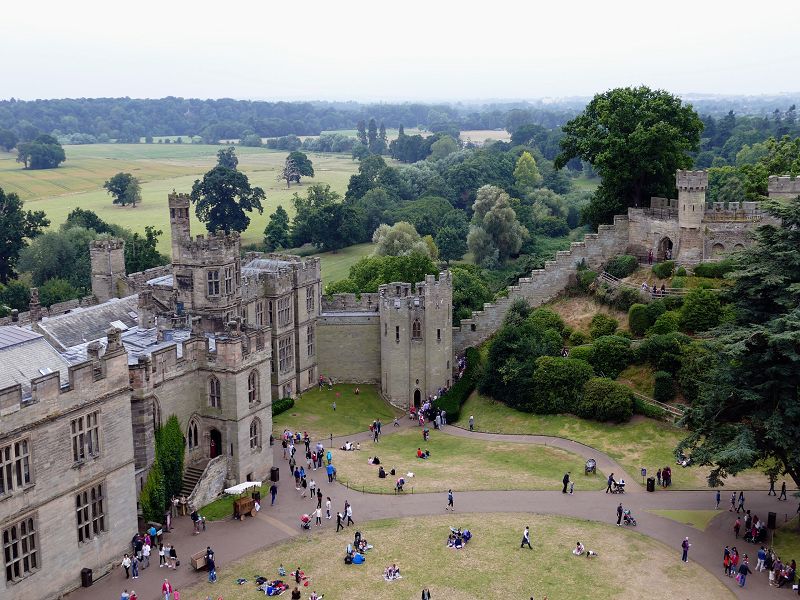
Our next suggestion is Warwick Castle, not only because of its equally impressive history but the route leading to it. Leaving Sussex behind you can take the A3 all the way up to the West of London allowing you to stop over in the capital if you so choose. Heading onto Warwick Castle will also have you go by both Windsor and Oxford, great opportunities to stop and see Windsor Castle and the Oxford University grounds.
Warwick Castle was established by William the Conqueror himself two years after the invasion in 1068. It was built to maintain control of the Midlands as he advanced north. Established as a motte-and-bailey castle it was constructed upon a large mound (the bailey) with an enclosed courtyard (a motte).
William appointed Henry de Beaumont as constable of the castle who went on to become the first Earl of Warwick. However the wife of his son, Roger de Beaumont, was deceived into thinking her husband had died and surrendered the castle to the invading army of Henry of Anjou, who would become Henry II of England. Roger de Beaumont apparently died upon hearing his wife had simply handed over the castle. Henry later returned the castle to the De Beaumont family.
The castle was adapted into a stone keep castle under King Henry II and served to store provisions during the Baron’s Rebellion of 1173-74. The castle was taken in a surprise attack by William Maudit during the Second Baron’s War of 1264-67. The castle walls were near destroyed as to make it useless for storing and protecting provisions for the royal army. After Maudit’s death the castle and title passed to his nephew, William de Beauchamp 9th Earl of Warwick. Warwick Castle remained under De Beauchamp ownership for 180 years where a lot of additions and repairs were made.
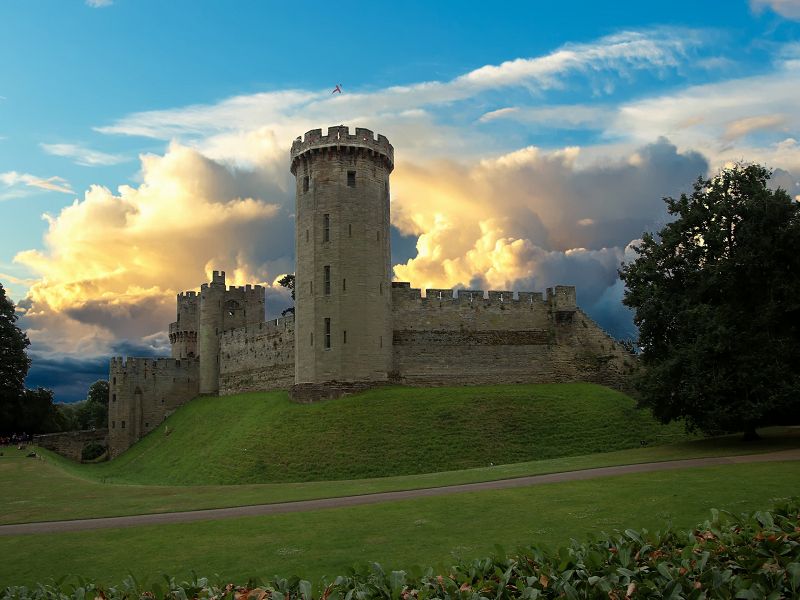
In 1469 the current Earl of Warwick, Richard the kingmaker Neville, rebelled against the crown and even imprisoned Edward IV of England inside Warwick Castle! This was during the 100 year civil war known as the War of the Roses. By the 1480s Richard III, King of England, had control of Warwick and had two gun towers begin under construction, Bear and Clarence Towers, but were not completed before his death in 1485.
The Castle was under the care of the Crown between 1478 until 1547 until the second creation of the Earl of Warwick went to John Dudley. For a long time Warwick Castle was in a state of decay, and even when Elizabeth I visited in 1566 and 1572, a wooden lodging had to be constructed within to house her. When Ambrose Dudley died in 1590 the Earldom of Warwick was for a second time no more.
In the 17th Century the grounds were turned into a garden and the defences were enhanced in the 1640’s to prepare it for the English Civil War, where it went under heavy siege. It was only by 1759 that Francis Greville successfully petitioned for the title Earl of Warwick, reuniting the earldom and the castle once more.
Much of the lavish interiors and gardens were constructed over the next couple of hundred years, again hosting monarchs such as Queen Victoria. There was unfortunate fire damage in 1871 that was thankfully controlled and did not damage the structure.
Now the castle is owned by the Tussaud’s Group and is an incredibly fun English getaway. Stay in Medieval style tents for some ‘glamping’ while spectating Medieval shows and falconry, or take part in archery and Jester’s school. There are also lodges and luxury suites, the sheer size and history of Warwick castle means it can take more than just an afternoon to explore it all.
- Distance from Arundel: 136 miles, 2h 34 min
- Distance from Oxford: 46.8 miles, 54 min
- Distance to Windsor: 82 miles, 1 h 23 min
Nottingham Castle
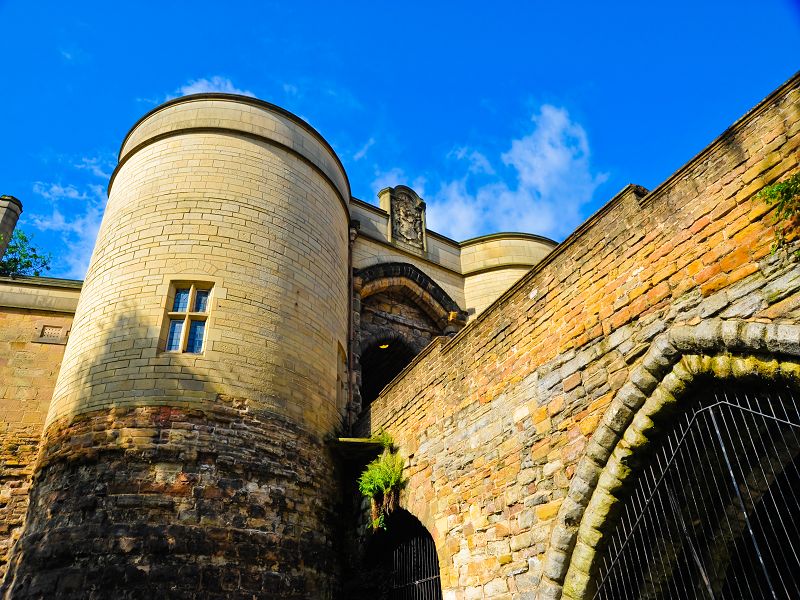
Following our Norman conquest of England another great stop would be Nottingham Castle. Not only does this take you to the iconic city of Nottingham, famous for its historic puts, ghost stories and nature reserves, but it also sets you close to England’s Peak District National Park – an incredible area for outdoor enthusiasts.
This castle too started its humble beginnings as a wooden structure of motte-and-bailey, built in 1068 two years after the Battle of Hastings. William the Conqueror ordered the construction and it was also made into a defensible stone castle during the reign of King Henry II. It was designed though with more complicated architecture, with both upper and middle and outer baileys, the middle being used for royal apartments.
The castle was often used to house nobles and royalty being at a key position to the River Trent, as well as being by royal hunting grounds such as Tideswell. Nottingham Castle is also by Sherwood forest, the setting of the English legend Robin Hood, and in the story it is in the castle where the outlaw has his last showdown with the infamous Sherriff of Nottingham, who actually did occupy the castle during the Third Crusade when King John The Lionheart was away fighting.
The castle was the setting of a historic battle in 1194 when the standing King Richard put down a rebellion by Prince John.
Later in 1384 it was again the stage of royal power taking when King Edward III, aided by Sir William Montagu, staged a coup against his own mother Isabella of France. She and her lover Roger Mortimer were acting as Regents until Edward came of age and were unwilling to relinquish power and even murdered the King Edward II. On a dark night on October 19th, Montagu and companions were assisted by William Elan who was the castle’s overseer and knew of a secret tunnel. Once in, they dispatched Mortimer’s guards and arrested the two lovers. Mortimer was sent to hang at the Tower of London while the Queen Mother was forced into retirement at Castle Rising Castle in Norfolk.
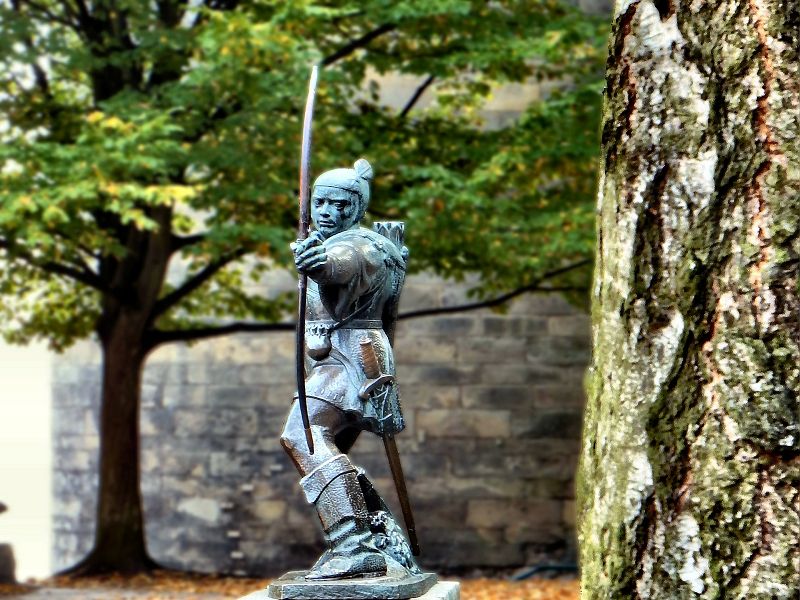
Edward III was considered a strong and capable king who had great military success during his long reign. He used Nottingham Castle frequently to hold parliament. Kings after him Richard II also used it to hold various councils.
Only by the War of The Roses (100 year civil war) did it become used militarily again, with Edward IV proclaiming himself king in in Nottingham in 1476. Unfortunately the castle would become obsolete and desolated by artillery during the Civil war in the 17th Century. It was no longer a place for royalty and after the execution of Charles I in 1649 the caste was razed as to not be used again.
However restoration was carried out under Charles II in 1660 and the now standing ‘Ducal Mansion’ was built by Henry Cavendish, 2nd Duke of Newcastle. Some rock cut cellars and medieval pointed arches still survive, and guided tours are available today through what is known as ‘Mortimer’s Hole’.
Ducal Mansion now serves as an art gallery and museum with more restoration done to the original medieval structures, beautiful grounds, and a sprawling cave system. There are new interactive exhibitions on the castle’s 1000 year history as well as the legend of Robin Hood.
- Distance from Warwick: 59.8 miles, 1h 12 min
- Distance to Tideswell (Peak District National Park): 43 miles, 1h 13 min
Clifford’s Tower
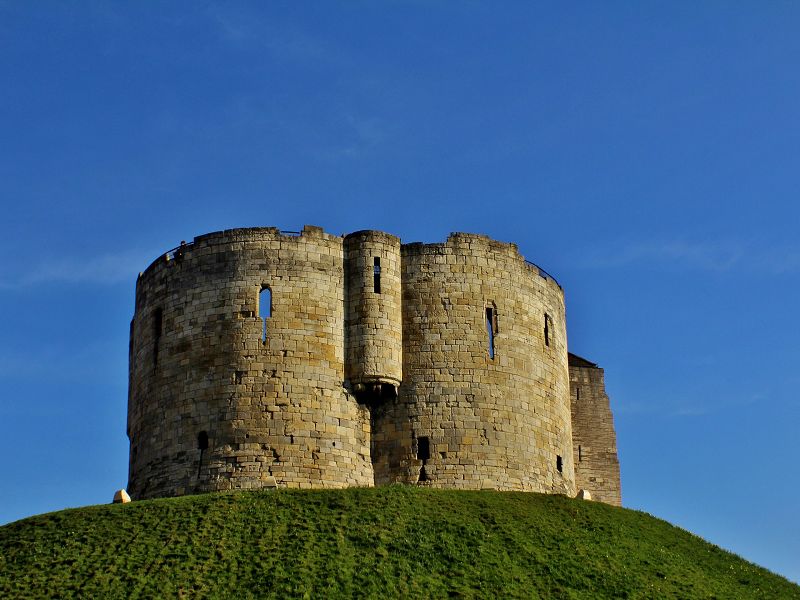
The final stop on the Medieval castle tour is in York, which was the Viking capital of England in the 10th Century. In 1068 William the Conqueror built a number of castles across the north-east during his campaign, including this one in York. The city itself is beautiful and one of the oldest in England, being founded by the ancient Romans. It’s a perfect place to visit because you can also take a direct route south west taking you through Leeds, Manchester and Liverpool, perfect for an extended day trip or night out – and especially easy and affordable by car.
The first castle built by William in York was erected between the rivers Ouse and Foss, the site of the present-day castle. He ordered the building of a second one during his second northern campaign in 1069 on what is now Baile Hill.
He did so under concerns of invasion, however a Viking fleet invasion still occurred by river resulting in many of the houses and the two castles in York being burned and damaged. In 1069 much development was undertaken to fortify York including the building of a moat and large artificial lake called the King’s Pool. It took so much dispersion of water that eventually the second castle was abandoned in favour of the first, with its motte still there today.
Henry II visited York castle four times during his reign, paying partially for its upkeep. Castle mills were built close by in the support of the military, with the Knights Templar being granted ownership.
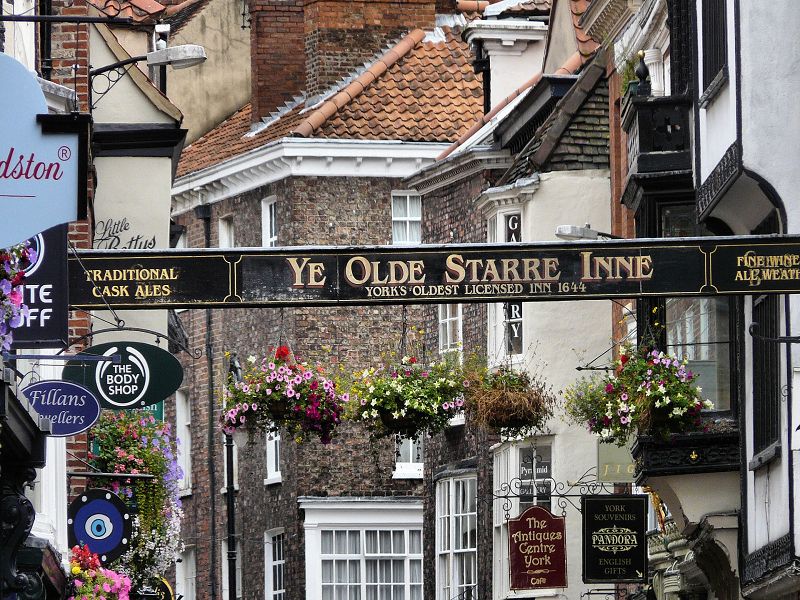
York Castle was partially adapted into a prison during King John’s reign, who used the castle a great deal. It was during this time that a system of castle guards were put in place as well as lands granted to knights for extra protection. Henry III kept up this fortification and had the castle rebuilt in limestone to protect against invading Scots, also building two large towers, two small gatehouses, as well as a chapel and stone keep among other improvements, most notably the stone keep now known as Clifford’s tower that stands atop the motte.
Over the next centuries the castle remained a key location in the North due to its water defences. It became used more as a jail with powers handed over to the sheriffs of Yorkshire, though during 1298 and 1338 many Westminster governing institutions found themselves based within the castle on the King’s orders. For example the Exchequer (in charge of the country’s money) took home in Clifford’s tower.
The castle became essentially ‘the northern capital’ for the Royalist cause during the Civil war in the 1600’s and though in disrepair and much of it privately sold, was reclaimed and garrisoned, surviving the siege of York in 1644. In 1684 a fire swept through Clifford’s tower giving it it’s now pinkish colour to the limestone exterior.
The prison was used throughout the 18th, 19th and even up to the 20th Century. During which time the conditions were reportedly terrible and often criticised. The problem was so ongoing that much of the castle including Clifford’s tower were purchased by the county of Yorkshire in 1825. The prison itself was closed in 1929.
Now it is open to the public and declared a heritage site. There is a Victorian street built to be a replica of the time with authentic shops, a famous art and history museum, tours of Clifford’s tower as well as shops and exhibitions. Be sure to look ahead at its program as there are constant events.
- Distance from Nottingham: 87.8 miles, 1h 44 min
- Distance to Leeds: 26.6 miles, 44 min
- Distance to Manchester: 72.8 miles, 2h 2 min
- Distance to Liverpool: 102 miles, 2h 6 min
The full trip route:
By Ed Sherrington